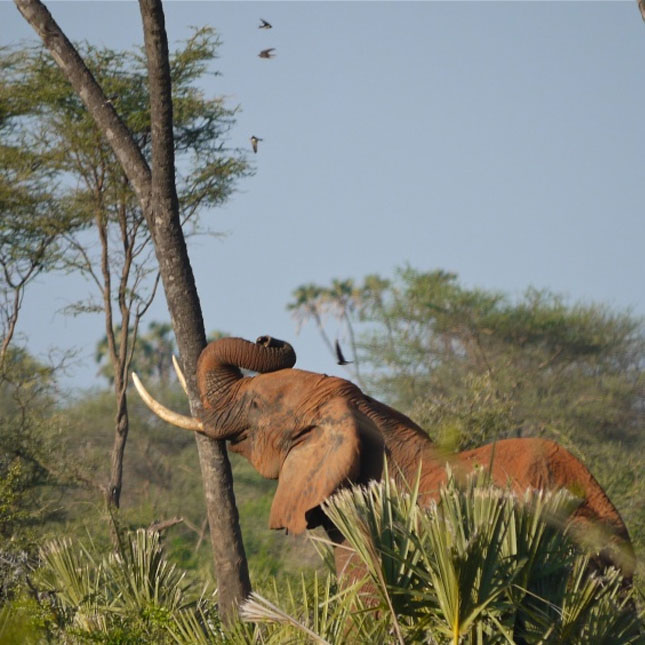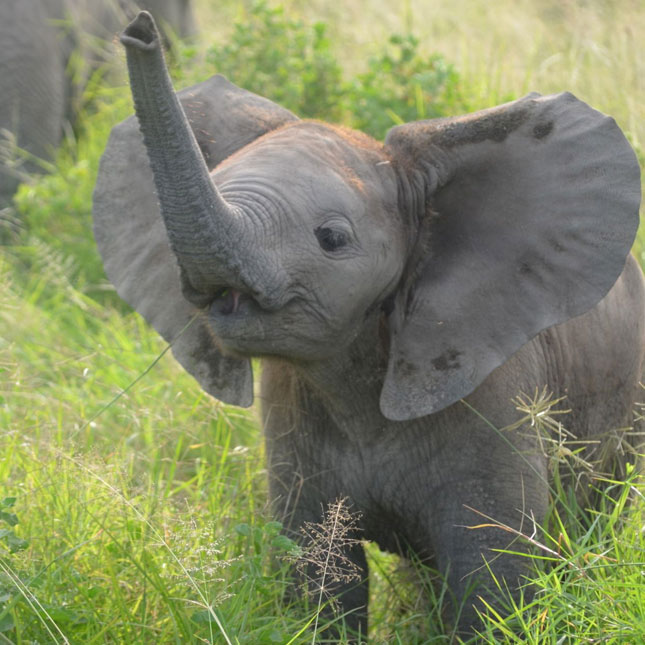About Elephants

1. Trunk.
An elephant’s trunk is kind of like a nose, in that it is used for breathing and smelling (as much as four times as sensitive as a bloodhound!) but it is also used for grabbing things and spraying water. The trunk can hold 8.5 litres of water to spray over the elephant or into its mouth. They use their trunks as a snorkel when they swim. (Yes, they can and do swim!) And they nuzzle them, wrapping them around one another, when they’re with an elephant they like.

2. Ears.
There are African elephants (actually, there are two species: African bush and African forest) and Asian elephants (one species). African elephants have ears in the shape of Africa and Asian elephants have smaller ears in the shape of India, if you use a little imagination. Elephant’s ears are also full of blood vessels and they’re used to regulate body temperature. Blood flows into the ear and the elephant flaps its ear to cool down.

3. Feet.
Those big round feet are covered in a cushiony pad to help distribute weight. They also soften the sound of the footsteps. That’s right: a 10-foot tall, 7-ton elephant can sneak up on you.

4. Skin.
On its back and the back of its head, an elephant’s skin can be an inch thick. It is generally grey, though it can become depigmented on Asian elephants. And it is quite sensitive to sun. For this reason, after taking a bath, they will wallow in mud or blow dust over itself for protection against the sun and insect bites.

5. Tusks.
One of the elephant’s great problems is its ivory tusks, which make the giants a target for poaching. The tusks are actually incisor teeth. They grow quite large on African males, smaller on African females; Asian males have tusks slimmer than African males or may have no tusk at all. Asian females have small tusks, or the tusks are absent. The tusks are used for digging, for fighting and for protecting the trunk.

6. Keystone species: the good.
Elephants change the landscape around them. They can dig holes, looking for water, which other animals then use. They eat and disperse seeds over long distances.

7. Keystone species: the bad.
They can compress the earth, causing rain to flow instead of seep into the ground, which leads to erosion. And they can uproot the trees in a savannah (a mixed ecosystem), turning it into a grassland.

8. Musth.
Musth is a period mature males go into once per year, usually during the rainy season and usually for one to two months. Their testosterone rates are 60 times the non-musth rate and they secrete a tarry fluid from the temporal ducts behind their eyes. They become extremely aggressive. Oddly enough, though, musth isn’t directly correlated with mating. Females go into estrus about once per year but not during a specific season. A female will choose a musth male over a non-musth male to mate with, but a male does not need to be in musth to mate.

9. Elephant painters.
You’ve probably heard of elephant “artists” that paint pictures, holding the paintbrush in their trunks. There are reports that the elephants, particularly those that make non-abstract paintings, are trained and guided quite fiercely. However, in the instance of Ruby, an elephant at the Phoenix Zoo that lived from 1973 to 1998, she was apparently quite inspired to create art, chose what colours to use and was very particular about them.

10. More neat elephant things.
The average life span of African elephants is 60 to 70 years and of Asian elephants, 48 years. The trunk has no bones; it is made of muscle with cartilage at the opening, separating it into two nostrils. Baby elephants trip over their trunks when the are learning to walk. They go through six sets of teeth in a lifetime. They are afraid of bees.
– Shauna Dobbie Copyright©
Pegasus Publications Inc.




